Newly identified cell explosions involved in bacterial secretion and adherence

Bacteria cells change from a rod-like to spherical shape before exploding controlled by the Lys enzyme. Cell membrane fragments curl up to form vesicles and extracellular DNA are released, which can interact with other cells. Credit: University of Tsukuba
Membrane vesicles are tiny spheres that develop from bacterial membranes and contain a mixture of proteins, DNA, and RNA. They are important for the virulence of the bacterium–its ability to cause disease–as they play vital roles in invasion, secretion, and signaling.
They also contribute to the formation of biofilms, the slimy three-dimensional structures that form when bacteria adhere to moist surfaces such as teeth or wounds. Extracellular (e)DNA is a key structural organization of biofilms, yet it was not known how certain structural proteins or eDNA are released.
To answer this, the researchers used live cell microscopy of the pathogenic bacterium Pseudomonas aeruginosa to reveal that cells quickly changed from rod- to round-shaped, and explode. “Cells lose their structural integrity in 5-10 seconds,” corresponding author Cynthia Whitchurch of the University of Technology Sydney explains, “and the explosion releases cellular content including eDNA, proteins, and membrane fragments into the surrounding environment.”
Using super-resolution microscopy to follow the explosions, they found a surprising observation described by first author Lynne Turnbull: “We observed that membrane fragments produced by exploding bacteria curled up to form membrane vesicles that captured eDNA and other cellular components released by the explosion.”
Co-corresponding and co-first author Masanori Toyofuku of the University of Tsukuba and University of Zurich explains that, “this was completely unexpected as until now bacterial membrane vesicles were thought to form from membranous protrusions at the cell surface.”
The team found that the explosions are caused by an enzyme (Lys) used by bacteria-infecting viruses (phages) and phage-like elements to disrupt the cell wall of their hosts. Using a mutant bacterial strain incapable of producing Lys, they discovered that the enzyme was needed to produce eDNA and membrane vesicles.
Through a range of experiments, the team also demonstrated that exposure of cells to different forms of stress, such as antibiotics or DNA damaging agents, stimulated expression of the gene encoding Lys and induced explosive cell lysis. “This shows that the bacterial 'SOS' response triggers explosive cell lysis in response to unfavorable environmental conditions,” co-corresponding author Leo Eberl of the University of Zurich says.
This mechanism may enable bacteria to release important cellular factors for use by bacterial communities as public goods, and knowledge of its control could be used to interfere with biofilm formation of pathogenic bacteria.
Media Contact
Masataka Watanabe
kohositu@un.tsukuba.ac.jp
81-298-532-039
Media Contact
All latest news from the category: Life Sciences and Chemistry
Articles and reports from the Life Sciences and chemistry area deal with applied and basic research into modern biology, chemistry and human medicine.
Valuable information can be found on a range of life sciences fields including bacteriology, biochemistry, bionics, bioinformatics, biophysics, biotechnology, genetics, geobotany, human biology, marine biology, microbiology, molecular biology, cellular biology, zoology, bioinorganic chemistry, microchemistry and environmental chemistry.
Newest articles

“Nanostitches” enable lighter and tougher composite materials
In research that may lead to next-generation airplanes and spacecraft, MIT engineers used carbon nanotubes to prevent cracking in multilayered composites. To save on fuel and reduce aircraft emissions, engineers…

Trash to treasure
Researchers turn metal waste into catalyst for hydrogen. Scientists have found a way to transform metal waste into a highly efficient catalyst to make hydrogen from water, a discovery that…

Real-time detection of infectious disease viruses
… by searching for molecular fingerprinting. A research team consisting of Professor Kyoung-Duck Park and Taeyoung Moon and Huitae Joo, PhD candidates, from the Department of Physics at Pohang University…





















